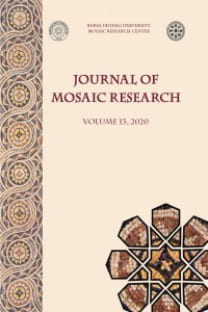The Mosaics with Geometric Patterns from the West and the East of the Roman Empire: The Hourglass Pattern and the Significance of the "Le Décor Géométrique de la Mosaïque Romaine I-II "
İki mozaik döşemeye sahip bir ev keşfedildi ve özellikleri nedeniyle, Bracara Augusta'da (Portekiz) müze binasının bodrumunda tutulmaya karar verildi. Mozaik zeminlerden biri, zıt renkli dama tahtası deseninden oluşurken, diğeri kum saati motifinden meydana gelmiştir. Bu makalede farklı kompozisyonlara uygulanan kum saati motifi, Roma mozaik uluslararası tanımlama standardizasyonu yardımıyla ve Roma dünyasının batısından (Portekiz) doğusuna (Türkiye) aynı desen ile karşılaştırılarak sunulacaktır
Roma İmparatorluğu'nun Batısı ve Doğusu'ndan Geometrik Desenli Mozaikler: Kum Saati Motifi ve "Le Décor Géométrique de la Mosaïque Romaine I-II " kitabının önemi
The structures of a domus with two mosaics were discovered, and due to its features, it was decided to keep it integrated in the crypt of the Museum building in Bracara Augusta (Portugal). One of the mosaic floors consists on a chessboard pattern, with contrasting colours and the other is furnished with hourglass gridlines. A study of the hourglass motif integrated into different compositions will be presented here, helping to the international standardization of the description of the Roman Mosaic and trying to confront the same pattern from the West (Portugal) to the East (Turkey) of the Roman World
___
- Abraços 2005 Maria de Fátima Abraços, Para a História da conservação e restauro do mosaico romano em Portugal, Vols. I-III, Tese de Doutoramento. Faculdade de Letras da Universidade Clássica de Lisboa, Lisboa.
- Abraços 2006-2007 Maria de Fátima Abraços, "O Corpus dos mosaicos romanos de Portugal", Portugalia, Nova Série, Vol. XXVII - XXVIII: 54.
- Abraços 2008 Maria de Fátima Abraços, «Conservation et restauration des mosaïques romaines au Portugal - Quelques exemples dans les collections de musées», in Proceedings. Lessons learned: reflecting on the Theory and practice of mosaic conservation. Actas ICCM IX: 69-74.
- Abraços 2011 Maria de Fátima Abraços, "Os mosaicos romanos de Bracara Augusta da colecção do Museu Regional de Arqueologia D. Diogo de Sousa, Braga", O mosaico romano nos centros e periferias. Originalidades, influências e identidades. CMGR X: 827-835.
- Lancha 2000 Janine Lancha e Pierre André, Corpus Mosaicos romanos de Portugal II, CONVENTVS PACENSIS 1, A villa de Torre de Palma, IPM, Lisboa (= CMSP 1).
- Martins et al. 2012 Manuela Martins - J. Ribeiro - F. Magalhães - C. Braga, "Urbanismo e Arquitetura de Bracara Augusta. Sociedade, economia e lazer", in Evolução da paisagem urbana sociedade e Economia, Braga: 20-26, available online: http://repositorium.sdum.uminho.pt/bitstream/1822/19522/1/Urbanismo_e_arquitetura_de_Bracara_Augusta._Sociedade%2c_Economia_e_Lazer.pdf ).
- Oliveira 2010 Cristina Fernandes Oliveira, Mosaicos romanos de Portugal. O Algarve Oriental. Dissertação de outoramento em História, especialidade de Arqueologia Clássica apresentada à Faculdade de Letras da Universidade de Coimbra.
- Oleiro 1992 J. M. Bairrão Oleiro, Corpus dos Mosaicos Romanos de Portugal, Conventus Scallabitanus, I, onímbriga -Casa dos Repuxos, IPM/MMC, Conímbriga.
- Ovadiah 1980 Arthur Ovadiah, Geometric and floral patterns in ancient mosaics. A study of their origin in the mosaics from the classical period to the age of Augustus, L'Erma di Bretscheineder, Roma.
- Silva 1994 Isabel Silva e Carlos Guimarães, "A integração arquitectónica de um mosaico no difício do Museu regional de Arqueologia do Museu D. Diogo de Sousa - Braga", Actas ICCM V: 61-67.
- Viegas et al. 1993 Catarina Viegas - Fátima Abraços - Marta Macedo, Dicionário dos Motivos Geométricos no Mosaico Romano, Conímbriga
- ISSN: 1309-047X
- Başlangıç: 2008
- Yayıncı: Ululdağ Üniversitesi, Mozaik Araştırlmaları Merkezi
Sayıdaki Diğer Makaleler
Simonetta ANGIOLILLO, Chiara PILO
The mosaics with irregular tesserae in Albania (3rd - 1st century BC)
